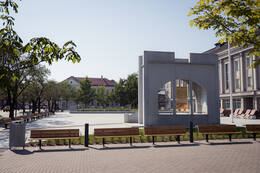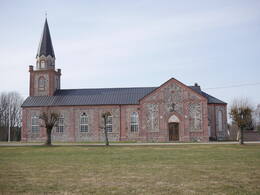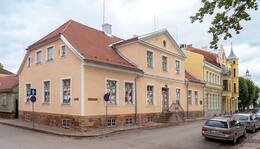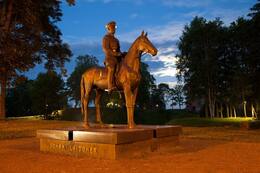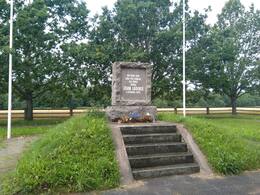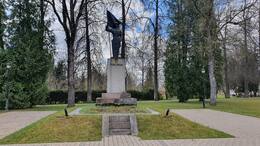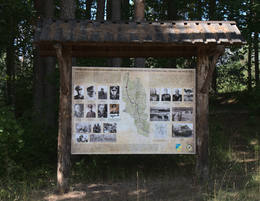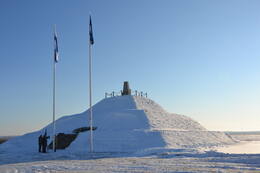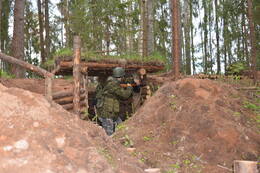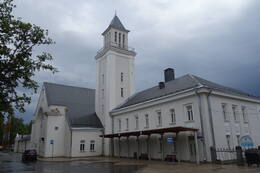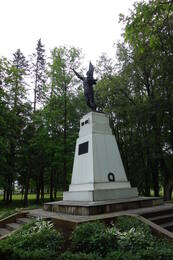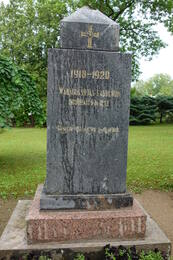In the footsteps of Estonian Independence War
War of Independence Monument in Pärnu
This monument was designed by Amandus Adamson. It was unveiled in Alevi cemetery in Pärnu on 16 July 1922. Its designer was buried next to it in 1929.
On 15 April 1945 the monument was blown to pieces, which were then buried. The statue of a boy with a garland was buried by local high school girls 175 metres from the monument. Luckily the graves of the soldiers were left untouched.
The garrison cemetery was renovated in 1987 and the parts of the monument (incl. statue of the boy with the garland) were dug up in 1988. On 24 February 1989 the upper part of the monument, which was found buried in its original location, was unveiled with a granite tablet reading: "1918 1920 / HERE WAS UNVEILED, ON 16 JULY 1922 THE MONUMENT TO THOSE / FALLEN IN THE WAR OF INDEPENDENCE / SCULPTOR AMANDUS ADAMSON / DESTROYED IN 1945 / 24 II 1989 P.M.S." The full restoration of the monument and cemetery was completed in stages. The monument was unveiled anew on 17 July 1993.
Monument to Proclaiming the Independence of the Republic of Estonia
This monument is situated on Independence Square in the centre of Pärnu.
Made from granite and designed by Kaarel Eelma, Mart Aas and Mikk Mutso, it was unveiled in 2008 near the former site of the Endla Theatre.
On 23 February 1918 the Manifesto to the Peoples of Estonia was publicly declared for the first time from the balcony of said theatre, which was badly damaged in World War II and later demolished.
The monument depicts the balcony of the historical theatre in its original size. It displays the text from the manifesto in both the original blackletter typeface and Antiqua, as well as in Braille.
The manifesto was published and the Republic of Estonia declared in the capital Tallinn on 24 February, transferring all authority to the Estonian Salvation Committee, later followed by the Provisional Government. 24 February 1918 is celebrated to this day as the anniversary of the Republic of Estonia.
Estonian Soldiers Memorial Church in Tori
Tori Church in Pärnu county, which was built in 1854, has a complicated past. The German Army burnt the church down in 1944 when retreating from the Red Army. Trees were already growing in the church hall when its restoration began in 1990. The church was consecrated in 2001 as a memorial to all victims of the Second World War and is now known as the Estonian Soldiers Memorial Church. The church is also used as a concert venue.
Monument to the War of Independence in Suure-Jaani
This monument was unveiled in Suure-Jaani cemetery on 24 June 1926, designed by Amandus Adamson. It depicts the ancient Estonian chief Lembitu, wounded, but still holding his sword aloft. The monument was demolished in 1941 and again in 1950. It was restored and unveiled anew on 23 June 1990. Following the first demolition, the bronze statue of Lembitu was placed in a shed belonging to the local executive committee and returned to its original place during the German occupation. After the second demolition of the monument in 1950, the damaged bronze sculpture, now missing one of its hands, was given to Viljandi Museum. A new bronze sculpture was cast for the restoration of the monument in 1990.
Museum of Viljandi
This museum is situated in the old pharmacy in the centre of Viljandi.
The main exhibition on both floors showcases the history of Viljandi County over the centuries. The museum also hosts unique temporary exhibitions.
Part of the main exhibition is dedicated to the military history of the region: World War I, the War of Independence, the declaration of the independence of the Republic of Estonia and World War II. The museum displays its military collections, including those of Lieutenant Colonel Martin-Friedrich Bergmann, Lieutenant Colonel Artur Tenno and Colonel Johannes-August Vellerind, consisting of their personal belongings, arms, documents, medals and decorations. Also on display is the collection of medals uncovered during the museum's renovations in 1999 belonging to the Sakala regional unit of the Defence League. The propaganda material and military equipment of both the Germans and the Soviets from 1940-1944 illustrate the World War II years and the dismantling of the Republic of Estonia. Part of the exhibition is dedicated to the mass deportations that took place and to the resistance movement of the Forest Brothers. The museum also screens films outlining the exhibitions.
Monument of General Johan Laidoner
The equestrian statue of General Johan Laidoner is situated near the castle hills in Viljandi.
This monument, designed by sculptor Terje Ojaver, was unveiled in 2004.
Dedicated to Commander-in-Chief General Johan Laidoner, it was the first and to date remains the only equestrian statue in Estonia. The prominent military man and politician, who was born in the county, was the first honorary citizen of Viljandi.
Place of Birth of General Johan Laidoner
The farmhouse on Raba Farm in the village of Vardja, where General Laidoner was born, has not survived. It is thought to have been destroyed before World War II, as a monument was erected in its place in 1937. The monument was demolished in 1940 and restored in 1990. In recent years people have been regularly placing candles at the old farmstead on the general's birthday, 12 February.
Monument to the War of Independence in Tarvastu
This monument was unveiled on 23 June 1937 in the small borough of Mustla. It was demolished on 18 June 1941 during the Soviet occupation before being unveiled anew on 12 July 1942 during the German occupation. In 1948 it was demolished again, and in 1990 the restored variant was unveiled. The monument was restored as per the original, with only some minor alterations. The centrepiece of the monument is its bronze soldier, who holds a flag in one hand and a shield depicting three leopards in the other. He stands on a granite plinth, which in turn rests on a two-stepped footing. The helmet being worn by the soldier is worth mentioning: it was modelled after the famous German Stahlhelm, reflecting the ‘colourful’ supply situation during the War of Independence.
Pikasilla battle field
This is a part of the defence line Walk. The Valga defence line (Walk) was built along the Väike Emajõe-Koiva river line in early June 1944. The northern part of the line ended at Lake Võrtsjärv and ran from Pikasilla almost all the way to Ligaste Manor, located on the left bank of Väike Emajõgi. The defence line consisted of two defence belts, occasionally reaching a depth of 10-12 kilometres. The front line was covered with barbed wire and mine fields. All bridges on Väike Emajõgi and Koiva rivers were destroyed (though the Pikasilla and Jõgeveste bridges were only destroyed at noon on 26 August) and all bridges behind the defence line were ready to be destroyed.
The Red Army planned the liquidation of the German and Estonian forces located at the Narva front with an attack via Tartu from their back. To conduct the plan, the Red Army 3rd Baltic Front leadership sent four units to the Emajõgi line. Their task was to cross Emajõgi River and, with a circular movement over the northern bank of Lake Võrtsjärv, occupy Northern Estonia with the German 18th Army located at the Narva front. They also planned to break German resistance on the Pikasilla-Valga line and cut off the German path of retreat towards Riga.
In Southern Estonia, the defence consisted of six divisions and smaller units of Wehrmacht’s XXVIII and XXXVIII Army Corps, with the rear defended by the 207th Reinforcement Division. At the beginning of the operation, the Red Army had a numerical advantage in manpower and battle equipment. The German forces mostly consisted of different battle groups and smaller units. The Omakaitse units participating in the defence were poorly equipped and had low battle morale.
On 27 August, the Red Army managed to cross Väike Emajõgi River at Pikasilla and held a small bridge head there. Until 13 September, the German and Estonian Omakaitse division managed to stop the advancing Red Army units on the defence line Walk. On 14 September, the divisions of the 3rd Red Army Baltic Front began their assault, breaking through the line of defence on 17 September.
Monument of Paju Battlefield
The Battle of Paju took place on 31 January 1919 during the War of Independence between the Tartu-Valga army group of the Estonian People's Force and the Red Army Latvian Riflemen for control over Paju Manor. The battle resulted in the Estonians gaining control over the strategically important town of Valga and its railway turnout. Julius Kuperjanov, who led the Estonian offensive, was fatally injured in the battle.
This monument was designed by architect Georg Saar. A campaign was organised to raise money for the monument. On 12 June 1938, the cornerstone was laid by General Johan Laidoner. The base was completed in 1940, but the monument itself went unveiled due to the Soviet occupation. On the 75th anniversary of the Battle of Paju on 30 January 1994, President Lennart Meri finally unveiled the monument.
Valga Military Museum-Theme Park
This museum and theme park showcases the internal security and military history of Valga and Estonia. The place is perfect for organising summer camps with field activities and a field trip to a World War II battle site near the Väike-Emajõgi River. The programme includes learning to cook pea soup (a popular dish in the military), using camouflage face paints and orienteering in the woods.
The exhibition at the theme park includes military equipment, artillery, an Mi-8 helicopter, a fire engine and various types of machine gun pillbox and naval mine. The tour ends at a Forest Brothers’ bunker, where, on prior request, an alcoholic beverage drunk by the Forest Brothers and smoked lard sandwiches with onion are served. For more serious enthusiasts, the museum displays the largest collection of weapons in Estonia. The Estonian Defence Forces, Police and Border Guard Board, Defence League and Internal Security Service organise demonstrations at the museum of the duties they carry out. They are joined in doing so by the Latvian Police, Border Guard and Fire and Rescue Services.
Defence Line "Walk"
The Valga defence line (Walk) was built along the Väike Emajõe-Koiva river line in early June 1944. The northern part of the line ended at Lake Võrtsjärv and ran from Pikasilla almost all the way to Ligaste Manor, located on the left bank of Väike Emajõgi. The defence line consisted of two defence belts, occasionally reaching a depth of 10-12 kilometres. The front line was covered with barbed wire and mine fields. All bridges on Väike Emajõgi and Koiva rivers were destroyed (though the Pikasilla and Jõgeveste bridges were only destroyed at noon on 26 August) and all bridges behind the defence line were ready to be destroyed. The second line ran along Õhne and Pedeli rivers and defence structures included the cities of Tõrva and Valga that were re-equipped to be points of resistance.
The main line of defence consisted of two sets of trenches, in the most important sections even three to four sets of well-developed trenches with connection systems. To build the defence line, the Germans used Russian prisoners of war and forcefully recruited the local population within Organisation Todt.
Trenches and fire trenches have been restored at the location. The area is used by the Valga Military Theme Park, which led the effort to restore the wartime appearance of the hill. The outdoor space was opened in 2015; the Valga Military Theme Park regularly organises laser weapon battles and other events on site.
The trenches and pillboxes have been restored in the former German fortified positions. The area is operated by the military theme park in Valga, which led the restoration work to revive the ridge's wartime look. The outdoor area, in which laser tag and special events are now held, was opened in 2015.
Valga railway station built by German prisoners of war
The main building of Valga railway station (Leningrad Transport Planning Office, architect: Viktor Tsipulin) was completed in 1949. It is an elongated two-storey structure with an avant-corps and a hipped roof, its architectural showpiece being its seven-storey square tower. It is one of the best and most remarkable examples of Stalinist architecture in Estonia. Its original state having been so well preserved further elevates its significance. The railway station was built shortly after World War II in place of a building from the imperial era that Soviet bombing had razed to the ground. Since German prisoners of war were detained in Valga, it is plausible that they were used to construct it.
Monument to the War of Independence in Valga
This monument, in remembrance of freedom fighters from Southern Estonia, depicts a statue of an unknown soldier, his sword sheathed, holding a flag in one hand and the other outstretched, standing on top of a tall plinth. The original monument was unveiled on the 31st birthday of Lieutenant Julius Kuperjanov on 11 October 1925, but was demolished by the Soviet regime on the night of 21 September 1940. It was unveiled anew at its original location on Kuperjanovi Street in Valga on 16 August 2013. The original monument was designed in 1925 by Amandus Adamson, who also oversaw the bronze sculpture's casting in Italy. It was restored to its full size by sculptor Jaak Soans. The restoration was organised by the non-profit organisation VIKP (Permanent Exhibition of Patriotic Education in Valga), the town and county government of Valga and the Estonian War Museum.
Monument to the War of Independence in Priimetsa cemetery
This monument was unveiled in this cemetery in Valga on 11 October 1925. It is found on one of the largest burial sites of the fallen in the War of Independence and is the final resting place for over 300 men. Alas, not all those buried were identified, so the monument bears just 154 names. The monument nevertheless mentions the 152 who were unable to be identified. The monument was knocked down in September 1940 but returned to its upright position in July 1941. After World War II the monument was toppled again and then buried.
It was unveiled anew in the same location on 27 November 1988, restored from its original parts. The monument is modest in design. It comprises a stepped base surmounted by an obelisk. The material used is grey granite.





